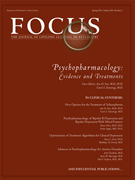Psychopharmacology of Bipolar II Depression and Bipolar Depression with Mixed Features
Abstract
Bipolar II Disorder: Clinical Context
Bipolar II Depression: Treatment Strategies and Evidence
Quetiapine
Lamotrigine
Lithium
Antidepressant Adjunctive Therapy
Antidepressant Monotherapy
Other Classes
Bipolar II Depression: Recommendations, Knowledge Gaps, and Future Directions
| Medication | Acute Therapy | Maintenance Therapy | ||
|---|---|---|---|---|
| Quetiapine | + | Post hoc analyses of 4 placebo-controlled studies | 0 | |
| Lamotrigine | +/− | Meta-analysis of 5 placebo-controlled studies | 0 | |
| Lithium | - | One placebo-controlled study (EMBOLDEN I) | + | Historical data, one open-label study |
| Antidepressant Adjunct | - | One placebo-controlled study (STEP-BD) | ? | One uncontrolled study, but enriched for antidepressant-responders (STEP-BD) |
| Antidepressant Monotherapy | - | One placebo-controlled study (EMBOLDEN II) | ? | One placebo-controlled study, but enriched for antidepressant-responders |
Bipolar Depression with Mixed Features: Historical and Clinical Context
| With mixed features: The mixed features specifier can apply to the current manic, hypomanic, or depressive episode in bipolar I or bipolar II disorder: |
| Depressive episode, with mixed features: |
| A. Full criteria are met for a major depressive episode, and at least three of the following manic/hypomanic symptoms are present during the majority of days of the current or most recent episode of depression: |
| 1. Elevated, expansive mood. |
| 2. Inflated self-esteem or grandiosity. |
| 3. More talkative than usual or pressure to keep talking. |
| 4. Flight of ideas or subjective experience that thoughts are racing. |
| 5. Increase in energy or goal-directed activity (either socially, at work or school, or sexually). |
| 6. Increased or excessive involvement in activities that have a high potential for painful consequences (e.g., engaging in unrestrained buying sprees, sexual indiscretions, or foolish business investments). |
| 7. Decreased need for sleep (feeling rested despite sleeping less than usual; to be contrasted with insomnia). |
| B. Mixed symptoms are observable by others and represent a change from the person’s usual behavior. |
| C. For individuals whose symptoms meet full episode criteria for both mania and depression simultaneously, the diagnosis should be manic episode, with mixed features. |
| D. The mixed symptoms are not attributable to the physiological effects of a substance (e.g., a drug of abuse, a medication, or other treatment). |
Bipolar Depression with Mixed Features: Treatment Strategies and Evidence
Bipolar Depression with Mixed Features: Recommendations and Future Directions
Conclusions
Footnotes
References
Information & Authors
Information
Published In
History
Authors
Funding Information
Metrics & Citations
Metrics
Citations
Export Citations
If you have the appropriate software installed, you can download article citation data to the citation manager of your choice. Simply select your manager software from the list below and click Download.
For more information or tips please see 'Downloading to a citation manager' in the Help menu.
View Options
View options
PDF/EPUB
View PDF/EPUBGet Access
Login options
Already a subscriber? Access your subscription through your login credentials or your institution for full access to this article.
Personal login Institutional Login Open Athens loginNot a subscriber?
PsychiatryOnline subscription options offer access to the DSM-5-TR® library, books, journals, CME, and patient resources. This all-in-one virtual library provides psychiatrists and mental health professionals with key resources for diagnosis, treatment, research, and professional development.
Need more help? PsychiatryOnline Customer Service may be reached by emailing [email protected] or by calling 800-368-5777 (in the U.S.) or 703-907-7322 (outside the U.S.).

